Social security agency: central functions location analysis
Report setting out evidence base for making a decision on where the social security agency’s centrally based functions will be located.
4. Phase 2 of location analysis - results
This chapter presents the results of Phase 2 analysis based on the performance of Local Authorities against the quantitative evidence on four location criteria, according to the scoring methodology described in Chapter 3. The full results are presented in Annex B.
4.1 Aggregate scores and ranking
When each of the four location criteria are equally weighed at 25% to give an overall score, the ranking of 15 Local Authorities is as shown in Figure 4. Figure 4 shows both the total scores, as well as the breakdown by each of the four criteria.
As the highest ranking Local Authority on 2 out of the 4 criteria (Ability to Recruit and Contribution to Local Delivery), Glasgow has the highest overall score of 7.7 out of a maximum of 10.0. North Lanarkshire is the second highest rated, followed by North Ayrshire. Similarly to Glasgow, North Lanarkshire scores well against Ability to Recruit and Contribution to Local Delivery. South Lanarkshire and Dundee City also ranked above the median.
North Ayrshire has the third highest score as it scores highly against Inclusive Growth and Regeneration criteria. Inverclyde and West Dunbartonshire have joint fourth highest scores. However, these three Local Authorities performed weakly against Ability to Recruit.
Aberdeen, Aberdeenshire and Edinburgh score very low overall, although Edinburgh's score is somewhat higher due to a high score for Ability to Recruit.
Figure 7 – Ranking of Local Authorities – Aggregate scores against 4 location criteria
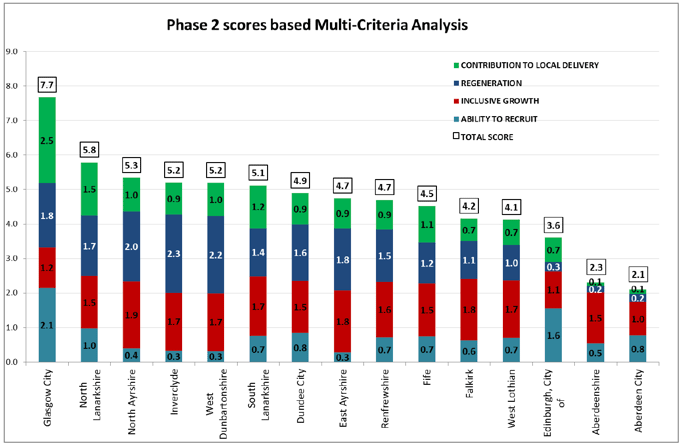
4.2 Ability to Recruit
The Ability to Recruit location criteria consists of 14 sub-indicators, including the size of the working-age population, population density, short-term unemployment levels, employment levels in similar occupations to agency staff, skill levels, education levels and business vacancies. Some of these indicators were chosen to reflect the largely administrative, advisory and caseworker staff profile of the agency.
Figure 8 - Ranking of Local Authorities based on Ability to Recruit criteria
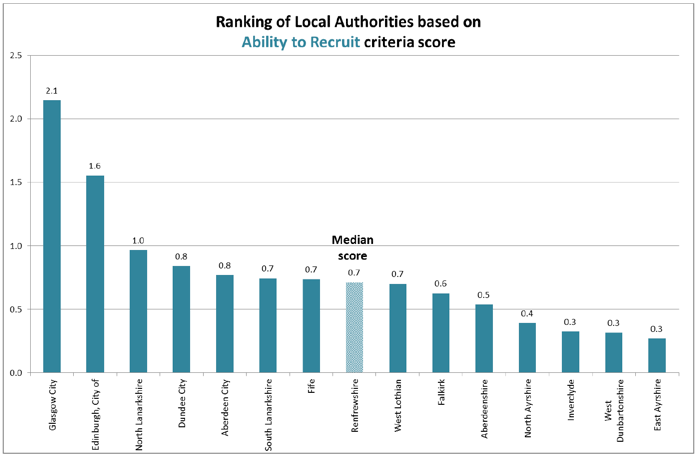
Glasgow is clearly the best performer in terms of the Ability to Recruit criteria, with a score of 2.1. Glasgow is not only the largest Local Authority in Scotland, it is also surrounded by many neighbouring Local Authorities with good transport links. Edinburgh similarly benefits because of these factors but to a lesser extent and therefore scores 1.6. Glasgow also has the highest number of staff currently employed in similar occupations to future agency staff, such as in administrative and secretarial and sales and customer service occupations.
With a score of 1.0, North Lanarkshire could be described as the 'best of the rest' in terms of its ability to recruit, but only marginally so, with a number of other smaller Local Authorities scoring at or just above the median score of 0.7. North Lanarkshire outperforms the rest because of a relatively high short-run unemployment levels, its proximity to other populated Local Authorities and the high number of people currently employed in occupations similar to agency staff.
Areas such as East Ayrshire, West Dunbartonshire and Inverclyde do not perform well against the Ability to Recruit criteria. This is driven by their relatively small population size (even after taking into account Local Authorities from which commuting is possible), poor skills and education levels and low numbers of people employed in occupations similar to that of future agency staff.
4.3 Inclusive Growth
The Inclusive Growth location criteria consist of 5 indicator sets: contribution to the economy, recent economic performance, employment opportunities, business creation and economic diversity. Local Authorities that demonstrated weaker performance against these indicators were assigned higher scores in terms of suitability for agency location.
Figure 9 - Ranking of Local Authorities based on Inclusive Growth criteria
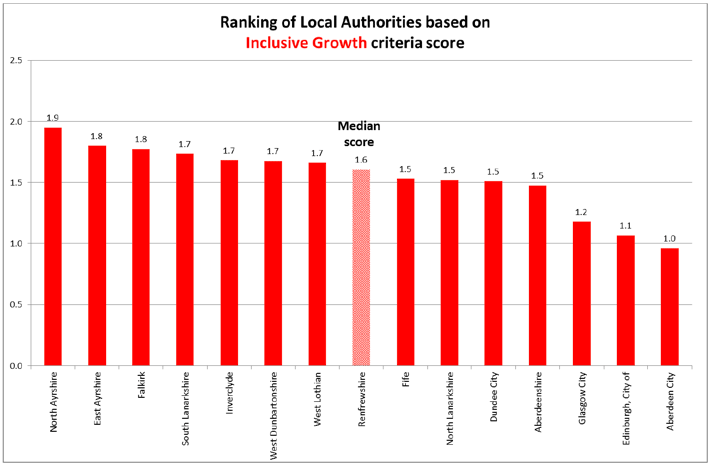
In contrast to Ability to Recruit, there is less variation in the Inclusive Growth scores, partly because this criterion is less influenced by the size of each Local Authority. North Ayrshire is the highest scoring Local Authority (1.9), just ahead of East Ayrshire and Falkirk which score 1.8 (note that this is the only criteria for which Falkirk scores above the median).
North Ayrshire and East Ayrshire's scores are driven by low Gross Value Added ( GVA) per working age person, negative GVA growth over the past decade, a high proportion of people who travel outside their home area for work and a low level of business creation.
Scotland's main cities (Edinburgh, Aberdeen, Glasgow and Dundee) perform poorly against these criteria. Dundee is a slight exception to this rule scoring 1.5, but still below the median of 1.7. This is partly driven by the fact that more working-age people are employed in these areas than live there due to the existing employment pull factor in these centres. These areas also have relatively high levels of GVA per worker, as well as strong GVA growth and high business birth rates.
4.4 Regeneration
The Regeneration location criterion consists of 4 indicators which are based on the Scottish Index of Multiple Deprivation ( SIMD) measures. These include: the proportion of datazones in a Local Authority that are ranked within the 20% most and least deprived in Scotland and the proportion of datazones in a Local Authority that are counted as income and employment deprived. The other 2 indicators used are population trend indicators, which show whether a Local Authority has experienced a long-term population decline.
Figure 10 – Ranking of Local Authorities based on Regeneration criteria score
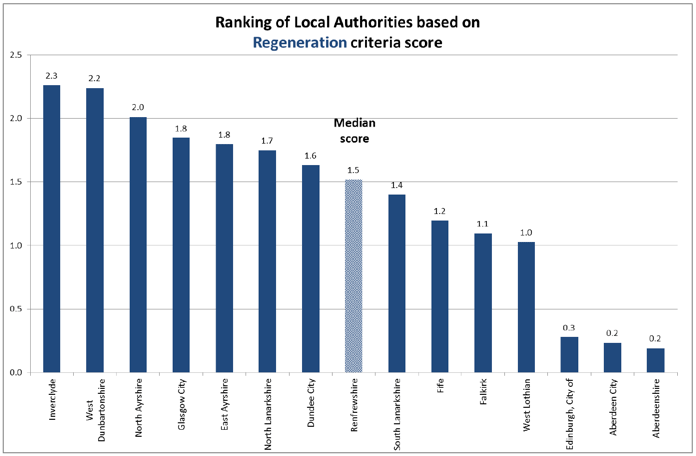
Two Local Authorities (Inverclyde and West Dunbartonshire) score particularly well against the Regeneration criterion. This is because not only are there high concentrations of deprived datazones in these Local Authorities (as captured through SIMD), but these are the only two areas in Scotland that have seen population declines over the past decade or so - indicative of a long-term structural decline in the local economy. Glasgow also performs well against this criterion, as it has the largest concentration of deprived datazones of any Local Authority.
Aberdeenshire, Aberdeen City and Edinburgh have particularly low scores against the Regeneration criterion. These areas have low proportions of deprived areas compared to other Local Authorities, and around 40% of datazones in Aberdeen and Edinburgh are among the 20% least deprived in Scotland. The population of Edinburgh has grown by 11% in the past decade or so, which is the highest rate of growth of any Local Authority.
4.5 Contribution to Local Delivery
The Contribution to Local Delivery location criterion consists of 6 indicators related to the level and concentrations of people in receipt of devolved benefits across the shortlisted Local Authorities. These include disability benefits (Attendance Allowance, Disability Living Allowance and Personal Independence Payments), Carer's Allowance and Child Tax Credits (a proxy measure for the Best Start Grant).
Figure 11 – Ranking of Local Authorities based on Contribution to Local Delivery criteria score
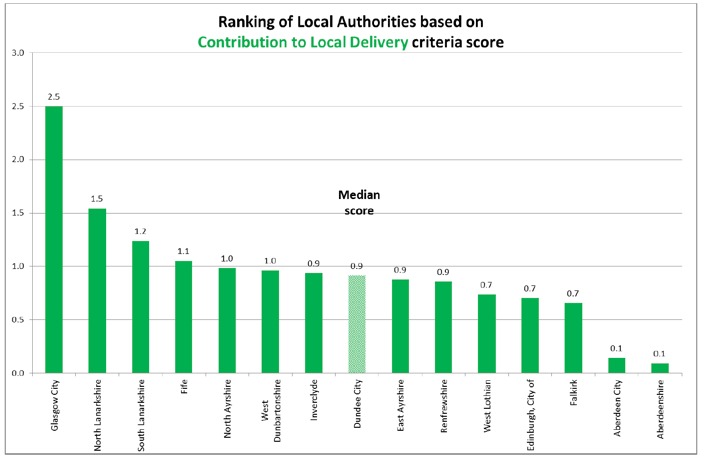
Glasgow is has the highest score against this criterion, due to both a very high number of claimants and the highest concentration of claimants per head of population. Aberdeen City and Aberdeenshire have both low levels and concentrations of claimants.
4.6 Recommended shortlist
In the analysis so far, each of the four location criteria have been equally weighted. However, the Ability to Recruit criteria is the most important criteria for successful delivery of the social security programme by the end of this Parliamentary term.
This risk around the agency's ability to recruit could be lowered by selecting the Local Authorities that have both higher than median aggregate score and higher than median score on Ability to Recruit.
This is presented graphically in Figure 12 which plots the Ability to Recruit scores against total scores for the other 3 location criteria for each of the 15 Local Authorities. Every Local Authority above the 'aggregate score median' line, has an overall score higher than the median and every Local Authority that is right of the 'ability to recruit median' line has a score above the median for that criterion.
This would mean that the areas that are assessed as being most suitable for agency location are Glasgow City, North Lanarkshire, South Lanarkshire, and Dundee City – the Local Authorities in the green shaded area of the chart.
The aim of Phase 2 analysis is to provide a robust assessment of how different Local Authority areas compare to each other against set of relevant criteria. Given the limiting factor of Ability to Recruit, the shortlist of four Local Authorities is the main result of this part of the analysis. Key information on each Local Authority area considered in Phase 2 is summarised in Local Authority profiles in Chapter 5.
Figure 12 – Phase 2 analysis results
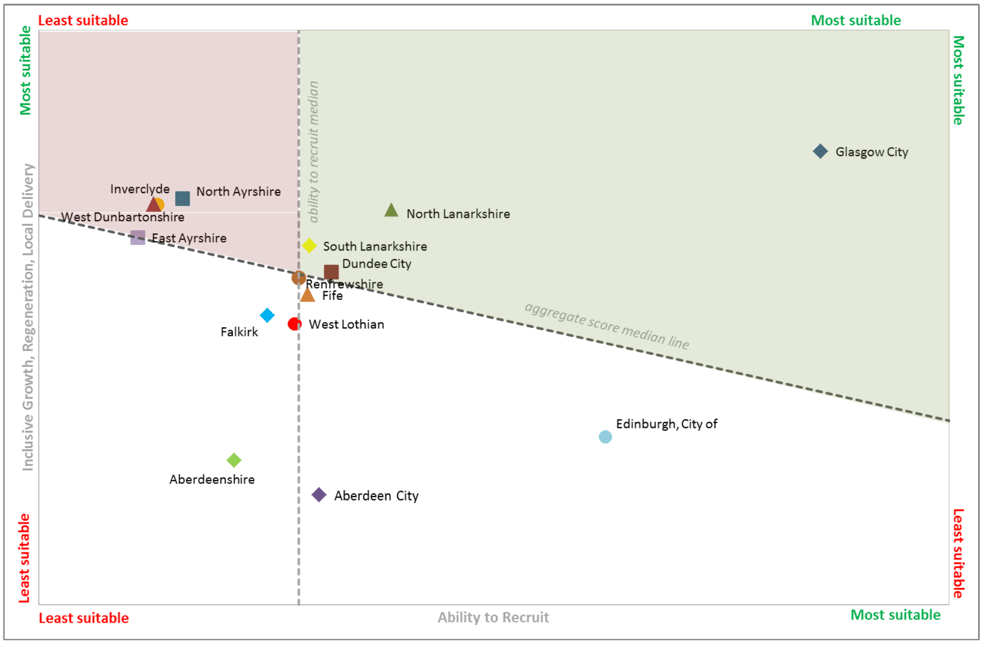
Contact
Email: Leila Akhoundova, leila.akhoundova@gov.scot
Phone: 0300 244 4000 – Central Enquiry Unit
The Scottish Government
St Andrew's House
Regent Road
Edinburgh
EH1 3DG
There is a problem
Thanks for your feedback